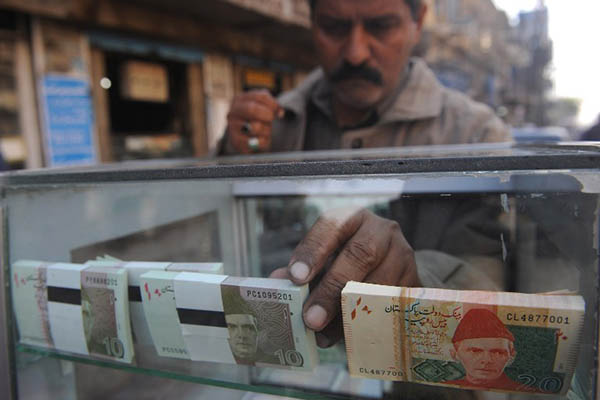
Rizwan Tabassum—AFP
Thanks in large part due to massive devaluation of the Pakistani rupee over the past year, the country’s per capita income shrank by 11.38% in the ongoing fiscal year, from $1,766 last year to $1,568 today.
According to data issued by the Pakistan Bureau of Statistics (PBS) after this week’s National Accounts Committee (NAC) meeting, the per capita income increased from Rs. 313,337 last year to Rs. 388,755 this year. However, the devaluation of the rupee against the U.S. dollar meant that in real terms, Pakistanis actually lost money under the government of Prime Minister Shehbaz Sharif. The PBS has fixed the average exchange rate for last year at Rs. 177.45/dollar compared to Rs. 247.86/dollar this year. According to observers, this shrinkage would likely reduce people’s savings—especially amidst record-high inflation—and make it more difficult to afford essentials.
The PBS’ official statement confirms that the NAC has estimated provisional growth rate of the country’s GDP at 0.29%. It said the growth of the agricultural, industrial and services sectors had been estimated at 1.55%, -2.94% and 0.86%, respectively. Despite the overall increase in the agriculture sector, it said, provisional growth in important crops had been estimated at -3.20% due to a 41% decrease in the production of cotton and 21.5% decrease in the production of rice. However, wheat produced had increased by 5.4%, sugarcane 2.8%, and maize 6.9%. Other crops, it said, had seen growth of 0.23% due to slight increase in production of pulses, vegetables, fodder, oil seeds, and fruits.
For the industrial sector, it said, mining and quarrying had seen a growth of -4.41% due to a decline in production of natural gas, crude oil, and exploration cost. Large-scale manufacturing posted a growth of -7.98% due to declines in production of food (-8.71%); tobacco (-23.78%); textiles (-16.03%); coke and petroleum products (-10.24%); chemicals (-6.29%); pharmaceuticals (-23.20%); fertilizers (-9.54%); non-metallic products, including cement (-10.75%); iron and steel products (-4.02%); electrical equipment (-11.15%); automobiles (-46.01%) and other transport equipment (-38.91%).
For the services sector, wholesale and retail trade industry showed growth of -4.46% due to decline in the output of crops; large-scale manufacturing and imports. The NAC estimated growth in the transportation and storage industry of 4.73%, while accommodation and food services activities grew by 4.11%. Information and communication increased by 6.93%, however the finance and insurance industry showed an overall decrease of -3.82%. Real estate activities grew by 3.72% while public administration and social security activities posted a growth of -7.76%. Education showed growth of 10.44% due to public sector expenditure, said the NAC, adding human health and social work activities increased by 8.49%, while provisional growth in other private services stood at 5%.
The provisional growth in livestock, forestry and fishing has been estimated at 3.78%, 3.93% and 1.44%, respectively. Electricity, gas and water industry shows a growth of 6.03%, per the NAC, while value-added in construction industry has registered a growth of -5.53%.
The overall size of the economy also shrank in dollar terms, from $375.45 billion last year to $341.55 billion in the outgoing fiscal year. This, again, was due to the currency devaluation, as in rupee terms the figures stood at Rs. 38.81 trillion last year compared to Rs. 38.93 trillion this year.
The government’s figures have raised questions over potential manipulation of data, as certain sectors have shown an unjustified increase, including the health and education sectors. The livestock sector, too, posted a moderate increase despite the government claiming millions of animals had perished in last year’s devastating floods.
